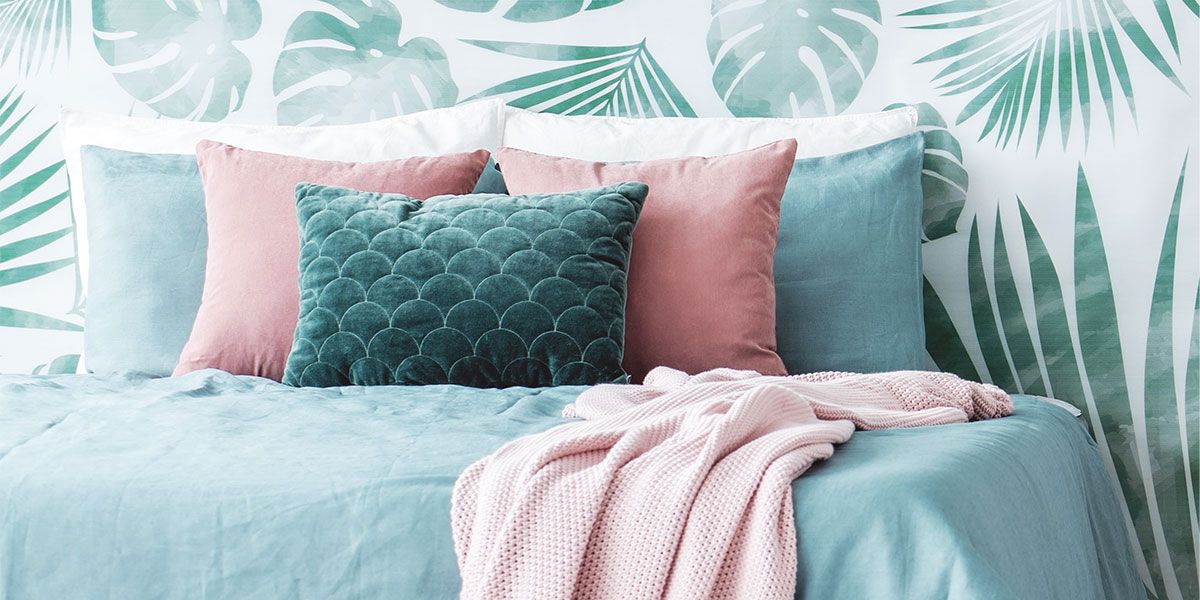CURATING HAPPINESS

Dopamine décor’s eclectic aesthetic aims to spark joy
Dopamine décor, a hot design trend that creates enriching environments, aims to make us happy. Named for dopamine, the “feel-good” neurotransmitter, the trend fuses neuroscience with interior design, intentionally transmitting love and happiness. The aesthetic advances an eclectic sensibility since what delights us varies according to our personal histories and tastes. But psychological research finds that bright colors and sensual textures paired with bold patterns and vintage pieces fuel the natural release of dopamine and spark joy. By mining the link between our environment and our emotions, dopamine décor designers conjure captivating spaces that curate happiness.
The scientific pillars of dopamine décor
Many research studies support dopamine décors’ aesthetic foundation. For example, color psychology finds that bold colors like red, yellow and orange stimulate dopamine. Click here on the Colors of the Year article for more on how these hues are trending.
Like its flashy fashion antecedent, “dopamine dressing,” dopamine décor boasts bright colors thought to boost your mood. When you start your dopamine décor design journey, begin with a pleasing color palette enriched by its monochromatic shades, tints and tones. Then insert pops of bold color in furniture, upholstery and throws for a refreshing uplift.
Cross-cultural studies show that people who work in lighter, brighter workspaces are more alert and joyful. Likewise, dopamine décor embraces layered and soft lighting from a variety of sources such as ambient chandeliers, cabinet task lighting, wall sconces and table lamps. These lighting sources cascade into a soothing yet well-lit atmosphere. Dimmable features enable you to customize the warm glow in each room.
Psychological research reveals that sensory-rich environments reduce anxiety and increase positive brain functions (Sampedro-Piquero et al). It’s therefore no surprise that sensual textures, bold patterns, and vintage pieces are touchstones of dopamine décor.
In The Aesthetics of Joy, Designer Ingrid Fetell Lee defines the dopamine décor philosophy: “As a decorating philosophy, dopamine décor emphasizes using bright colors, bold patterns and inviting textures to create a space that brings you joy. The idea is that each item of décor provides a little hit of pleasure in the brain, and that layering many of these pleasurable items together creates an environment that boosts your overall mental health.”
Dopamine décor eschews the aesthetic restraints of minimalism and celebrates maximalism’s abundance of color, texture and pattern. To this end, for a feeling of comfort and luxury, upholster your furniture with soft, sensual fabrics such as velvet and chenille. Ground all the bold elements with natural materials such as wood, stone and leather for a refreshing sensory contrast between smooth and rough. Exuberant geometric, abstract and floral patterns on fabrics and wallpaper can inspire joy without being chaotic. Display meaningful vintage and novelty items which evoke happy memories that enhance your well-being.
Sustainability in dopamine décor
Most furnishings and décor generate carbon dioxide emissions since they can’t be recycled and can end up in landfills. Dopamine décor extols vintage and nostalgic pieces that are repurposed and refurbished, minimizing your home’s carbon footprint.
Thinking back to your childhood, you may recall bright colors in your bedroom, in kindergarten and amusement parks. You likely dressed in bright hues and read colorful books. Thus, it may come as no surprise that dopamine décor includes nostalgia from the past. Antique furniture, art heirlooms, treasured books and vintage mementos also instill comfort and serenity.
A hallmark of dopamine décor, plants and greenery can enhance your home’s environment and your health. Whether you want to go big with a fiddle-leaf or keep it petite with a succulent on the sill, houseplants, especially this time of year, can spark joy.
What is dopamine?
Dopamine is a hormone and neurotransmitter produced in the brain when we experience something pleasurable. Glands release dopamine into the bloodstream, which then acts on organs and tissues that affect the body’s functions and emotions. Dopamine is also a neurotransmitter, which means it carries chemical messages across the spaces between nerve cells. It’s central to the reward pathway of the brain along with the other “happiness” hormones: serotonin, oxytocin and endorphins.
 Curating happiness and love
Curating happiness and love
Dopamine décor not only redefines trends in interior design, but it’s making great strides in understanding how our environment affects our wellbeing. It looks to science — specifically, the neuroscience behind dopamine — to create spaces that curate happiness. Ingrid Fetell Lee cites the research done by neurobiologists Semir Zeki and Tomohiro Ishizu, who scanned subjects’ brains as they look at art. Their conclusion: When subjects look at art that they think is beautiful, they experience an increase in activity in the reward center of the brain where dopamine resides and that is active when we’re in love. Wouldn’t it be blissful if every setting in which we entered evoked love and happiness through a dopamine rush? ✦
“feel-good” neurotransmitter, Chenille, color psychology, dopamine décor, dopamine dressing, endorphins, Interior Design, oxytocin, serotonin, Velvet









